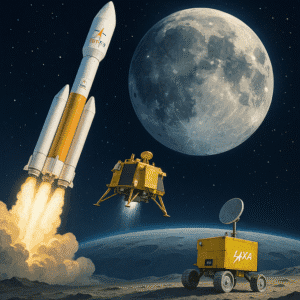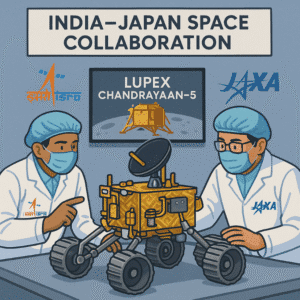LUPEX Mission (Chandrayaan-5): India–Japan Lunar South Pole Exploration
LUPEX Mission (Chandrayaan-5): ISRO–JAXA Lunar Polar Exploration & UPSC Notes
The LUPEX Mission, also known as LUPEX Chandrayaan-5, marks a significant chapter in India’s lunar south pole mission. This ambitious project is a joint collaboration between the Indian Space Research Organisation (ISRO) and the Japan Aerospace Exploration Agency (JAXA), reflecting the growing synergy in space diplomacy and scientific innovation.
Drawing insights from PIB and The Hindu, this article covers the LUPEX mission objectives, its technological framework, India’s strategic goals, and how New Careers Academy UPSC current affairs programs help aspirants preparing for NDA, CDS, CAPF, AFCAT, and Civil Services Examination (CSE) master such high-value topics.

Overview of the LUPEX Mission
The Lunar Polar Exploration Mission India (LUPEX) is ISRO’s fifth lunar venture, scheduled for launch in 2027–28 aboard Japan’s H3 heavy-lift rocket.
The Chandrayaan-5 mission 2027 comes after India’s successful Chandrayaan-3, which achieved the world’s first soft landing near the lunar south pole in 2023. LUPEX will build on this legacy with advanced technology and a sharper focus on in-situ exploration.
The mission has two core components:
An ISRO-developed lander capable of carrying heavy payloads and surviving lunar nights.
A JAXA-built rover designed for drilling and analyzing the regolith.
Together, they aim to transform the way humanity understands the Moon’s resources and potential.
LUPEX Mission Objectives
The primary LUPEX mission objectives are:
To locate, map, and quantify water ice deposits at the Moon’s south pole.
To analyze the quality and usability of lunar resources for future space settlements.
To test long-duration rover technologies in harsh lunar environments.
To provide key data for India’s future human lunar mission by 2040.
The rover, equipped with drills and spectroscopic tools, will explore beneath the lunar surface, studying regolith and ice up to several meters deep. Contributions from NASA and ESA add to the mission’s international scope.
Importance for Lunar Science and Human Space Exploration
The ISRO JAXA LUPEX mission is crucial because the lunar south pole contains permanently shadowed craters where sunlight never reaches. These “cold traps” likely hold ancient water-ice reserves.
Water ice is more than a scientific discovery—it could fuel:
Life support systems for astronauts.
Rocket propellant production, reducing Earth-dependency.
Long-term lunar bases, making human colonization viable.
LUPEX thus bridges science with strategy, advancing India’s lunar south pole mission as part of its larger vision for space leadership.

India–Japan Strategic Collaboration
The India Japan lunar mission is a model of technological cooperation:
ISRO’s lander expertise builds on Chandrayaan-3’s success.
JAXA’s rover experience enhances surface mobility and sample analysis.
Shared technologies include thermal management systems, advanced batteries, and autonomous navigation.
In August 2025, Prime Minister Narendra Modi highlighted LUPEX as a symbol of India–Japan innovation synergy, boosting industries, startups, and joint R&D. This mission also ties into NASA’s Artemis program, showing India’s growing role in global space partnerships.
Linkages with India’s Broader Lunar Program
The LUPEX mission fits into a structured lunar roadmap:
Chandrayaan-1 (2008): First mission; discovered lunar water molecules.
Chandrayaan-2 (2019): Orbiter successful; lander crashed.
Chandrayaan-3 (2023): First soft landing near south pole.
Chandrayaan-4 (~2027): Sample return mission.
Chandrayaan-5 / LUPEX (2027–28): India’s lunar south pole mission with international collaboration.
This progression shows India’s step-by-step approach: from discovery to technology demonstration, resource mapping, and eventually human presence on the Moon.
LUPEX UPSC Notes – Why It Matters for Exams
For UPSC and defense exam aspirants, LUPEX is an essential current affairs topic because it connects:
Science & Technology → Advances in lunar exploration.
International Relations → India–Japan cooperation, ties with NASA/ESA.
Strategic Studies → Space as a frontier for self-reliance and defense.
Key Takeaways for UPSC/Defence Exams
LUPEX is Chandrayaan-5: A joint ISRO–JAXA lunar polar mission.
Launch window: 2027–28 on Japan’s H3 rocket.
Core goal: Detect and analyze water ice at the south pole.
Links to: Artemis, Atmanirbhar Bharat, space diplomacy.
How New Careers Academy Helps Aspirants
New Careers Academy UPSC current affairs programs ensure aspirants stay ahead:
Weekly PIB & The Hindu sessions decoding missions like LUPEX.
MCQs and essay writing practice tailored to space and defense topics.
Monthly current affairs digests highlighting LUPEX mission objectives.
Guidance on linking LUPEX Chandrayaan-5 with GS2/GS3 papers.
Editorial reviews for interview prep on India’s space diplomacy.
This makes NCA a powerful resource for NDA, CDS, CAPF, AFCAT, and UPSC candidates.
Future Prospects and Challenges
LUPEX faces major challenges, including:
Navigating rugged, shadowed terrain at the lunar south pole.
Extreme cold survival for lander and rover systems.
Ensuring contamination-free sample collection.
Coordinating with global space agencies on data sharing.
Overcoming these hurdles will elevate LUPEX as a milestone in India–Japan lunar exploration and strengthen India’s ambition for a human mission by 2040.
Conclusion
The LUPEX Mission, or LUPEX Chandrayaan-5, is more than a scientific venture—it’s a strategic leap for India and Japan in space diplomacy and technology. As the Lunar Polar Exploration Mission India, LUPEX will determine how humanity uses the Moon as a stepping stone for deeper space exploration.
For aspirants, mastering LUPEX UPSC notes is essential for exams, while New Careers Academy UPSC current affairs programs ensure comprehensive coverage of such landmark developments.
By 2027–28, LUPEX could redefine how we see the Moon—not as a barren rock, but as the foundation of future human exploration.
MCQs on LUPEX Mission
1. The LUPEX Mission, also known as Chandrayaan-5, is jointly developed by:
a) ISRO and NASA
b) ISRO and JAXA
c) ISRO and ESA
d) ISRO and Roscosmos
Answer: b) ISRO and JAXA
2. What is the primary objective of the LUPEX Mission?
a) To map lunar magnetic anomalies
b) To bring lunar rock samples back to Earth
c) To detect and analyze water ice at the lunar south pole
d) To establish a permanent lunar base
Answer: c) To detect and analyze water ice at the lunar south pole
3. The LUPEX Mission (Chandrayaan-5) is scheduled to be launched on which rocket?
a) GSLV Mk III (ISRO)
b) H3 Rocket (JAXA)
c) Falcon Heavy (SpaceX)
d) Ariane 6 (ESA)
Answer: b) H3 Rocket (JAXA)
4. LUPEX Chandrayaan-5 forms part of which broader roadmap in India’s space program?
a) India’s Mars Colonization Program
b) India’s Lunar Exploration Roadmap toward a human lunar mission by 2040
c) India’s Asteroid Mining Program
d) India’s Venus Exploration Mission
Answer: b) India’s Lunar Exploration Roadmap toward a human lunar mission by 2040
5. Which of the following missions directly preceded LUPEX, achieving the first soft landing near the lunar south pole?
a) Chandrayaan-1 (2008)
b) Chandrayaan-2 (2019)
c) Chandrayaan-3 (2023)
d) Chandrayaan-4 (2027-planned)
Answer: c) Chandrayaan-3 (2023)





